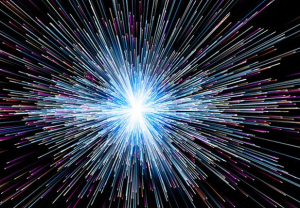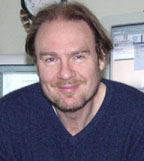 According to the electro-gravity model, there is no energy transfer in the force produced by a static gravity field. It can therefore be postulated that electro-gravity ‘waves’ have propagation speeds much greater than that of the speed of light.
According to the electro-gravity model, there is no energy transfer in the force produced by a static gravity field. It can therefore be postulated that electro-gravity ‘waves’ have propagation speeds much greater than that of the speed of light.
I may also speculate that it is possible to describe this as a quantum tunneling effect, where the light energy is absorbed on the transmitter side and re-appears on the receiver side – without any travel time between.
The light on the receiver side may not even be the same light, so the speed of the light limit is really not broken. In other words, as expected the mass-energy is not moving faster than light, only the pulse information is moving faster.
It has now been found that recent light speed experiments (L J Wang et al. 2000 Nature 406 277) have surprised the scientific community with reports of speeds of information that is 300 times the speed of light.
NEC Research Institute in Princeton Jonathan Leake
“SCIENTISTS claim they have broken the ultimate speed barrier: the speed of light.
In research carried out in the United States, particle physicists have shown that light pulses can be accelerated to up to 300 times their normal velocity of 186,000 miles per second.
The implications, like the speed, are mind-boggling. On one interpretation it means that light will arrive at its destination almost before it has started its journey. In effect, it is leaping forward in time.
The exact details of the findings remain confidential because they have been submitted to Nature, the international scientific journal, for review prior to possible publication.
The work was carried out by Dr. Lijun Wang, of the NEC research institute in Princeton, who transmitted a pulse of light towards a chamber filled with specially treated cesium gas.
Before the pulse had fully entered the chamber it had gone right through it and traveled a further 60ft across the laboratory. In effect it existed in two places at once, a phenomenon that Wang explains by saying it traveled 300 times faster than light.
The research is already causing controversy among physicists. What bothers them is that if light could travel forward in time it could carry information. This would breach one of the basic principles in physics – causality, which says that a cause must come before an effect. It would also shatter Einstein’s theory of relativity since it depends in part on the speed of light being unbreachable.
This weekend Wang said he could not give details but confirmed: “Our light pulses did indeed travel faster than the accepted speed of light. I hope it will give us a much better understanding of the nature of light and how it behaves.”
Dr. Raymond Chiao, professor of physics at the University of California at Berkeley, who is familiar with Wang’s work, said he was impressed by the findings. “This is a fascinating experiment,” he said.
In Italy, another group of physicists has also succeeded in breaking the light speed barrier. In a newly published paper, physicists at the Italian National Research Council described how they propagated microwaves at 25% above normal light speed. The group speculates that it could be possible to transmit information faster than light.
Dr. Guenter Nimtz, of Cologne University, an expert in the field, agrees. He believes that information can be sent faster than light and last week gave a paper describing how it could be done at a conference in Edinburgh. He believes, however, that this will not breach the principle of causality because the time taken to interpret the signal would fritter away all the savings. “The most likely application for this is not in time travel but in
speeding up the way signals move through computer circuits,” he said.
Wang’s experiment is the latest and possibly the most important evidence that the physical world may not operate according to any of the accepted conventions.
In the new world that modern science is beginning to perceive, sub-atomic particles can apparently exist in two places at the same time – making no distinction between space and time. Separate experiments carried out by Chiao illustrate this. He showed that in certain circumstances photons – the particles of which light is made – could apparently jump between two points separated by a barrier in what appears to be zero time. The process, known as tunneling, has been used to make some of the most sensitive electron microscopes.
The implications of Wang’s experiments will arouse fierce debate. Many will question whether his work can be interpreted as proving that light can exceed its normal speed – suggesting
that another mechanism may be at work.
Neil Turok, professor of mathematical physics at Cambridge University, said he awaited the details with interest, but added: “I doubt this will change our view of the fundamental laws of physics.”
Wang emphasizes that his experiments are relevant only to light and may not apply to other physical entities. But scientists are beginning to accept that man may eventually exploit some of these characteristics for inter-stellar space travel.”
… from Times Newspapers Ltd, June 4, 2000:
Further reading:
- ABCNews – Speed of Light No Longer the Limit “
- Faster than a speeding photon
- Faster than the speed of light tunneling (with lots of references and links)
- Faster than the speed of the light wave

I dare you all to make a real working time travel machine that can travel to the past, and make it public accessible,